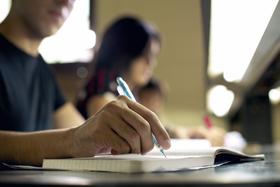Serving 47 students in grades 7-12, Jennings Experiential High School ranks in the bottom 50% of all schools in Minnesota for overall test scores (math proficiency is bottom 50%, and reading proficiency is bottom 50%).
The percentage of students achieving proficiency in math is <50% (which is lower than the Minnesota state average of 56%). The percentage of students achieving proficiency in reading/language arts is <50% (which is lower than the Minnesota state average of 51%).
The student-teacher ratio of 9:1 is lower than the Minnesota state level of 13:1.
Minority enrollment is 74% of the student body (majority Black), which is higher than the Minnesota state average of 39% (majority Black).
Quick Facts (2025-26)
- School Type: Charter School
- Grades: 7-12
- Enrollment: 47 students
- Student-Teacher Ratio: 9:1
- Minority Enrollment: 74%
- Graduation Rate: <50% (Btm 50% in MN)
- Math Proficiency: <50% (Top 1%)
- Reading Proficiency: <50% (Top 50%)
- Source: National Center for Education Statistics (NCES), MN Dept. of Education
Top Rankings
Jennings Experiential High School ranks among the top 20% of public schools in Minnesota for:
Category
Attribute
Percent Eligible For Free Lunch
Community Size
Student Attention
School Overview
Jennings Experiential High School's student population of 47 students has declined by 45% over five school years.
The teacher population of 5 teachers has stayed relatively flat over five school years.
School Type
Grades Offered
Grades 7-12
(No virtual instruction)
(No virtual instruction)
Total Students
47 students
Gender %
Total Classroom Teachers
5 teachers
School Calendar
School Rankings
The diversity score of Jennings Experiential High School is 0.71, which is more than the diversity score at state average of 0.59. The school's diversity has stayed relatively flat over five school years.
Math Test Scores (% Proficient)
(18-19)<50%
56%
Reading/Language Arts Test Scores (% Proficient)
<50%
51%
Student-Teacher Ratio
9:1
13:1
American Indian
28%
2%
Asian
n/a
7%
Hispanic
2%
12%
Black
38%
12%
White
26%
61%
Hawaiian
n/a
n/a
Two or more races
6%
6%
All Ethnic Groups
Graduation Rate
<50%
84%
Participates in the National School Lunch Program (NSLP)
Yes
Eligible for Free Lunch
83%
36%
Eligible for Reduced Lunch (19-20)
3%
8%
School Statewide Testing
School District Name
Source: National Center for Education Statistics (NCES), MN Dept. of Education
Profile last updated: 02/09/2025
Frequently Asked Questions
What percent of students have achieved state testing proficiency in math and reading?
<50% of students have achieved math proficiency (compared to the 56% MN state average), while <50% of students have achieved reading proficiency (compared to the 51% MN state average).
What is the graduation rate of Jennings Experiential High School?
The graduation rate of Jennings Experiential High School is 50%, which is lower than the Minnesota state average of 84%.
How many students attend Jennings Experiential High School?
47 students attend Jennings Experiential High School.
What is the racial composition of the student body?
38% of Jennings Experiential High School students are Black, 28% of students are American Indian, 26% of students are White, 6% of students are Two or more races, and 2% of students are Hispanic.
What is the student-teacher ratio of Jennings Experiential High School?
Jennings Experiential High School has a student ration of 9:1, which is lower than the Minnesota state average of 13:1.
What grades does Jennings Experiential High School offer ?
Jennings Experiential High School offers enrollment in grades 7-12 (No virtual instruction).
What school district is Jennings Experiential High School part of?
Jennings Experiential High School is part of Jennings Community School District.
In what neighborhood is Jennings Experiential High School located?
Jennings Experiential High School is located in the Saint Anthony Park neighborhood of Saint Paul, MN. There are 8 other public schools located in Saint Anthony Park.
School Reviews
Review Jennings Experiential High School. Reviews should be a few sentences in length. Please include any comments on:
- Quality of academic programs, teachers, and facilities
- Availability of music, art, sports and other extracurricular activities
Recent Articles

School Vouchers: Updated Pros and Cons (2025 Review)
Comprehensive 2025 analysis of school vouchers, weighing benefits and challenges for families, funding, outcomes, and policy directions.

Benefits and Drawbacks of Homework in 2025
Explore updated 2025 insights on homework’s benefits, drawbacks, mental health impact, best practices, and policy trends in U.S. public schools.

Charter Schools vs Public Schools 2025: Key Differences & Trends
Explore updated 2025 insights comparing charter schools vs public schools, enrollment, academic outcomes, funding, and real-world examples for families and educators.






